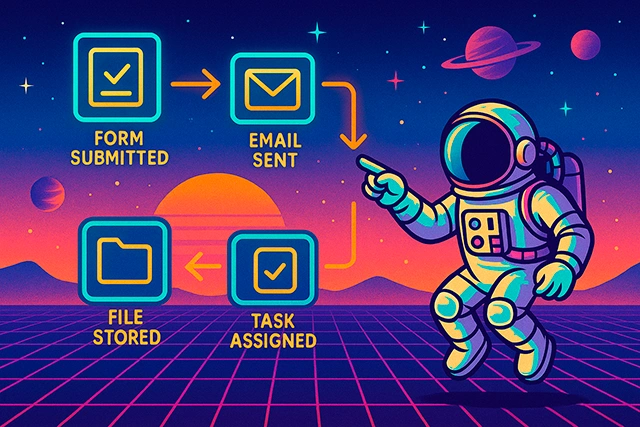From Manual Tasks to Workflow Automation Software and Seamless Systems

Managing business operations manually is not only time consuming but also prone to human error. In today’s competitive digital environment, businesses that rely on outdated systems risk falling behind. Workflow automation software is becoming a key driver of operational efficiency, helping companies transition from scattered, manual tasks to structured, seamless systems.
Whether you’re running a small business or managing enterprise level processes, automation tools can help you streamline approvals, eliminate repetitive actions, and give your team back valuable time. This guide breaks down what workflow automation is, how it works, and which tools are leading the way in 2025.
Table of Contents
What Is Workflow Automation Software?
Workflow automation software is a solution designed to automate repetitive processes, approvals, and communications within a business. It allows teams to map out a sequence of actions and trigger them automatically eliminating the need for manual intervention in routine tasks.
Instead of chasing down documents or waiting for email responses, businesses can build workflows that handle everything from file uploads to internal notifications.
Definition and Key Concepts
At its core, workflow automation is about defining a set of rules and letting software execute them. For example, when a form is submitted, the system can automatically send it to the right department, log the data, and notify a manager for approval.
Most modern workflow automation platforms support:
- Drag-and-drop workflow builders
- Predefined triggers and conditional logic
- Integration with cloud services like Google Drive and Dropbox
These integrations allow for real-time document syncing, file storage, and collaboration without switching platforms.
Why Businesses Need Workflow Automation
As organizations scale, managing daily operations manually becomes inefficient. Workflow automation reduces bottlenecks and ensures that tasks are completed on time, every time.
Key benefits include:
- Higher efficiency and fewer errors
By eliminating manual steps, businesses reduce the likelihood of missed tasks or incorrect data entries. - Improved collaboration and visibility
Team members can view task statuses in real time, get alerts when actions are needed, and access shared documents directly from integrated platforms.
Workflow automation also enhances accountability by assigning clear ownership to each step of a process, making it easier to audit and optimize performance over time.

Benefits of Using Workflow Automation Tools
As more businesses embrace digital transformation, workflow automation is no longer just a competitive advantage. It has become essential. From saving operational costs to strengthening team collaboration, the right software can fundamentally change how your business operates day to day.
Whether you run a small agency, a growing e-commerce brand, or a large enterprise, these benefits apply across industries and team sizes.
Time and Cost Efficiency
One of the most immediate benefits of workflow automation is saving time. By automating routine tasks like invoice approvals or data entry, teams spend less time on repetitive work and more time on strategy.
Real-life example:
A small marketing agency reduced 40% of its internal workload by automating client onboarding and contract approvals. What used to take days now takes minutes, with fewer errors and faster turnaround.
The result? Lower overhead, faster service, and happier clients all from a few smart automations.
Streamlined Document Management
Workflow automation tools often include file management features or integrate seamlessly with third-party platforms. This allows documents to be automatically stored, shared, or moved through stages of review without manual handling.
For businesses that rely on digital assets, this eliminates version control issues and prevents delays due to missing or misplaced files.
Looking for a secure and scalable way to manage your documents? Explore our guide to Cloud Storage for Business to see how the right setup complements your workflow automation.
Enhanced Team Collaboration
Automation doesn’t replace your team it empowers them. By providing clear task assignments, due dates, and status updates, workflow software helps team members stay aligned and accountable.
Most platforms integrate directly with project management tools like Asana, Trello, or Slack, making it easy to update tasks, send notifications, and coordinate across departments without extra effort.
From marketing teams launching campaigns to HR departments onboarding employees, everyone benefits from clear, automated processes that reduce guesswork and boost productivity.
Best Workflow Automation Software in 2025
Choosing the right workflow automation software depends on your team’s needs, technical skills, and the complexity of your processes. Some tools are designed for non-technical users with drag-and-drop interfaces, while others offer deeper customization for developers and enterprise teams.
Below is a comparison of top-rated tools categorized by their use cases, pricing model, and strengths.
Cloud-Based and SaaS Tools
These platforms are ideal for businesses that want fast setup, strong integration options, and cloud-first architecture.
| Tool | Description | Pricing | Link |
|---|---|---|---|
| Zapier | No-code automation platform to connect 6000+ apps and automate tasks easily | Freemium | zapier.com |
| Make (formerly Integromat) | Visual workflow builder for complex scenarios with advanced control | Freemium | make.com |
| Kissflow | Business process automation for teams and enterprises | Paid only | kissflow.com |
| N8N (cloud) | Open-source automation hosted in the cloud with high flexibility | Freemium | n8n.io |
Open Source and No-Code Options
Perfect for businesses that want full control over their data, on-premise deployment, or budget-friendly solutions.
| Tool | Description | Ideal For | Link |
|---|---|---|---|
| N8N (self-hosted) | Open-source automation tool with custom scripting and webhook support | Developers | n8n.io |
| Huginn | Self-hosted agent system for tasks like scraping, alerting, and automating | Tech-savvy users | github.com/huginn |
| Appsmith | Low-code tool for building internal apps and custom workflows | Internal teams | appsmith.com |
Software for Specific Use Cases
These tools are tailored for particular industries or departments that have recurring workflow needs.
| Use Case | Recommended Tools |
|---|---|
| Legal workflows | Clio, PracticePanther, MyCase |
| Marketing automation | ActiveCampaign, Autopilot, Mailchimp Automations |
| Remote teams | Notion Automations, Zapier, Slack integrations |
Each of these tools has its strengths. Some excel at automating simple app-to-app tasks, while others are powerful enough to build enterprise-grade systems. Make sure to consider factors like pricing, integration capabilities, and ease of use when selecting one for your business.
Pros and Cons of Popular Workflow Automation Software

Zapier
Best for: Non-technical users, marketers, small businesses
✔️ Pros
- Very easy to use for beginners
- Supports 6000+ app integrations
- Prebuilt templates for quick setup
❌ Cons
- Expensive at higher usage levels
- Limited logic branching in basic plans
- Not ideal for complex workflows

Make (formerly Integromat)
Best for: Advanced users, developers, complex automation setups
✔️ Pros
- Visual workflow builder with advanced control
- Excellent debugging tools and logs
- Affordable and powerful free tier
❌ Cons
- Steeper learning curve than Zapier
- UI can be overwhelming for beginners
- Slower task execution under free plan

Kissflow
Best for: Enterprises and mid-sized teams with structured processes
✔️ Pros
- Built for structured business process automation
- Includes forms, reporting, and case management
- Enterprise-ready scalability
❌ Cons
- No free plan
- Rigid interface for non-corporate workflows
- Requires time to onboard

n8n
Best for: Developers and teams needing full control or self-hosting
✔️ Pros
- Fully open-source with great flexibility
- Self-hosting options for full control
- Custom scripting capabilities
❌ Cons
- Not beginner-friendly
- Requires maintenance when self-hosted
- Fewer prebuilt integrations

Huginn
Best for: Developers building private agents and monitoring systems
✔️ Pros
- Self-hosted agents for scraping, monitoring, alerts
- Highly customizable
- Lightweight and private
❌ Cons
- Developer-level setup required
- No official support or UI polish
- Limited documentation for new users

Appsmith
Best for: Building internal tools, dashboards, and admin panels
✔️ Pros
- Open-source internal tool builder
- Connects easily to APIs, databases, services
- Custom UI with minimal code
❌ Cons
- Focused more on dashboards than workflow automation
- Requires basic coding and data structure knowledge
- Can be technical for new users
Choosing the Right Workflow Automation Software
Selecting the right workflow automation software requires more than just comparing features on a checklist. You need a platform that aligns with your team’s structure, handles your daily operational complexity, and grows with your business. A poorly matched tool can slow down progress, create unnecessary tech debt, or lead to low adoption across departments.
Whether you’re a solo founder, part of a marketing team, or running enterprise IT systems, these are the key areas to evaluate before choosing your automation platform.
Key Features to Look For
A strong workflow tool isn’t just powerful it’s intuitive. The best solutions offer a balance between ease of use and deep functionality. Here’s what to prioritize:
- Visual workflow builder
Drag-and-drop editors help users build, visualize, and manage workflows without coding. This is especially valuable for non-technical teams. - Conditional logic and branching paths
A good automation system can handle if-then logic, multiple triggers, approvals, or fallback actions especially useful for complex business scenarios. - Wide app integration library
Choose tools that natively connect to apps your team already uses Slack, Trello, Google Sheets, CRM systems, email, and file storage. - Error handling and fallback steps
If a step fails, can the workflow retry, notify someone, or roll back? This matters for mission-critical automations. - Real-time logs and versioning
Transparency is key. Being able to track, test, and roll back workflows gives teams control and confidence.
The goal is to find a system that fits your technical comfort level while still offering depth when needed.
Pricing and Scalability
Automation starts small maybe an invoice approval or a Slack notification. But over time, it becomes a backbone of how your company operates. That’s why scalability is non-negotiable.
- Freemium tiers
Great for testing, these typically come with limited tasks, users, or frequency. Ideal for early-stage startups. - Subscription models
As your usage grows, expect pricing based on task volume, number of integrations, or team members. - Enterprise pricing
Suited for large scale operations. This often includes SSO support, dedicated onboarding, SLA guarantees, and on premise deployment options.
Make sure to forecast your usage growth. A platform that seems affordable today might become costly once you’re processing thousands of tasks a month.
Also evaluate:
- API access limits
- Monthly execution caps
- Storage for logs and audit trails
- Priority support availability
Don’t let price surprises hit when it’s too late to migrate.
Security and Compliance
Workflow automation often touches sensitive business operations: client data, employee records, financial information. That means security isn’t optional it’s foundational.
- Compliance support
Look for platforms with certifications such as HIPAA, GDPR, SOC 2, or ISO 27001 if you’re in regulated industries. - Encryption
All data should be encrypted both in transit (SSL/TLS) and at rest on the server or cloud. - Access control
You should be able to manage who can edit workflows, access logs, and trigger specific flows. Role-based access control (RBAC) is essential. - Audit logs
Every action and trigger should be tracked. This ensures traceability and is critical for enterprise governance or legal compliance. - Self-hosted options
If you’re in fintech, legal, or government you may want to avoid public cloud SaaS altogether. Tools like n8n or Huginn give you that flexibility.
Security isn’t just an IT concern it protects your business, your brand, and your customers.

Use Cases: How Companies Use Workflow Automation
Workflow automation isn’t just for tech startups or enterprise IT teams it’s used across industries by companies of all sizes. From small teams looking to save time to global operations streamlining compliance, automation is now a key part of modern business infrastructure.
Below are two real-world examples of how companies are putting workflow automation to work.
Small Business Example
A boutique design agency with a five-person team used to spend hours each week on routine admin tasks onboarding new clients, collecting design briefs, and following up on unpaid invoices. Everything was tracked manually across spreadsheets and email.
After adopting a no-code workflow automation platform:
- Client intake forms automatically generate Trello cards and folders in Google Drive
- New projects trigger automated Slack notifications and assign tasks to designers
- Invoice reminders are sent via email and updated in QuickBooks without manual entry
This eliminated back-and-forth communication, reduced onboarding time by 60%, and freed up the founder to focus on sales and creative direction.
Even without technical expertise, the team was able to create powerful workflows using drag-and-drop tools.
Enterprise Use Case
A logistics company with over 200 employees was struggling with internal request handling from supply chain approvals to IT service tickets. Multiple departments were using siloed systems, leading to confusion, missed deadlines, and duplicated work.
They implemented a centralized workflow automation platform with deep integration capabilities.
Here’s how it changed their operations:
- Procurement approvals now follow a strict sequence with multi-level authorization
- Incident reports from field teams are routed automatically based on category and location
- HR processes like leave requests, onboarding, and compliance training are fully automated
With real-time dashboards and custom permissions, every department gained visibility and control. What used to take days like manual budget approvals now happens in hours.
The result? Fewer internal emails, clearer accountability, and measurable operational savings across the board.

Workflow Automation + Cloud Storage: A Perfect Match
Automating workflows is powerful on its own but when combined with cloud storage, it becomes unstoppable. File sharing, document access, and real-time collaboration are often at the core of many business processes. Without seamless integration between your workflow tools and your storage solution, things break down fast.
Here’s how cloud storage strengthens your automation strategy.
Syncing Documents in Real Time
Most workflows involve files proposals, contracts, reports, forms. Without real-time file syncing, users risk working on outdated documents or losing access entirely.
With cloud-integrated automation platforms:
- Documents can be automatically stored in the correct Google Drive folder based on the project name
- Uploaded files via forms are auto-renamed and sent to Dropbox for organized storage
- Triggered workflows can notify teammates in Slack the moment a file is updated in OneDrive
This creates a smooth handoff between people and systems, reducing friction and keeping everything up to date.
Securing Files While Automating Tasks
As files move through automated workflows, security is essential especially when dealing with HR records, contracts, or customer information.
Workflow automation platforms that integrate with trusted cloud storage providers help you:
- Maintain access control by folder or user role
- Track document changes and version history
- Set up alerts for unauthorized file movement or access
With encryption at rest and in transit, your business can automate confidently without compromising sensitive data.
Why Cloud Storage Matters in Workflow Automation
Without reliable cloud storage, workflows become disconnected, brittle, and difficult to manage. Cloud storage provides the foundation that ensures automated processes have a secure, always-accessible place to store and retrieve the assets they rely on.
If your business hasn’t yet invested in a scalable file management strategy, now is the time.
Frequently Asked Questions
What is workflow automation software?
Workflow automation software is a tool that helps businesses automate repetitive tasks and structured processes using predefined rules or logic. Instead of managing steps manually, it automatically routes information, sends notifications, updates files, or completes tasks based on triggers you define.
Who should use workflow automation tools?
Anyone who deals with repetitive tasks, multi-step approvals, or structured operations can benefit. This includes small businesses, remote teams, HR departments, IT support, legal firms, marketing agencies, and even solo entrepreneurs.
What are the best workflow automation tools for small businesses?
Some of the best tools for small teams include:
- Zapier – Easy to use, integrates with thousands of apps
- Make (Integromat) – More control and customization
- Kissflow – Designed for business process management
- n8n – For teams that need open-source and self-hosting flexibility
Can I use workflow automation without coding?
Yes. Many platforms like Zapier, Make, and Kissflow are designed for non-technical users with drag-and-drop interfaces. No coding is required to build useful workflows. You can also start with templates for common tasks.
Is workflow automation secure?
Reputable platforms follow strict security standards, including data encryption, role-based access, and compliance with GDPR or HIPAA. If security is a concern, look for tools with enterprise-grade security or self-hosted options like n8n or Huginn.
What’s the difference between workflow automation and business process management?
Workflow automation focuses on automating specific tasks or sequences. Business Process Management (BPM) is broader it involves designing, analyzing, optimizing, and managing entire business operations. Many workflow tools now offer BPM-lite features, but BPM suites are typically used at the enterprise level.
Final Thoughts: Is Workflow Automation Right for You?
If you’re spending too much time on repetitive tasks, chasing approvals, or manually updating tools just to keep projects moving workflow automation is not a luxury. It’s a necessity.
Whether you’re a freelancer managing clients, a startup trying to do more with fewer people, or an enterprise coordinating hundreds of requests a day, workflow automation can free up your time, improve accuracy, and help your team move faster.
Who Should Invest in It
- SMBs that want to streamline internal processes without hiring more staff
- Remote teams who need visibility and alignment across tools
- Agencies handling repetitive onboarding, feedback, or publishing tasks
- Enterprises managing approvals, compliance, or cross department coordination
If your team repeats the same steps more than twice a week that’s a good sign it should be automated.
Getting Started Without Coding Skills
You don’t need to be a developer to get started.
Platforms like Zapier, Make, and Kissflow offer drag and drop editors and templates to help you build workflows in minutes. For more control and scalability, tools like n8n and Appsmith give you flexibility while keeping your data secure.
The best part? You can start small automate one process, see the result, and scale from there.
Workflow automation isn’t about replacing humans it’s about letting your team do more of the work that matters.







